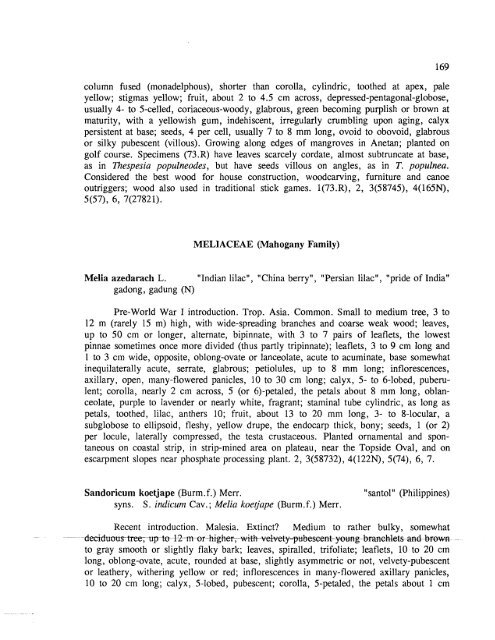atoll research bulletin no. 392 the flora of - Smithsonian Institution ...
atoll research bulletin no. 392 the flora of - Smithsonian Institution ...
atoll research bulletin no. 392 the flora of - Smithsonian Institution ...
You also want an ePaper? Increase the reach of your titles
YUMPU automatically turns print PDFs into web optimized ePapers that Google loves.
column fused (monadelphous), shorter than corolla, cylindric, too<strong>the</strong>d at apex, pale<br />
yellow; stigmas yellow; fruit, about 2 to 4.5 cm across, depressed-pentagonal-globose,<br />
usually 4- to 5-celled, coriaceous-woody, glabrous, green becoming purplish or brown at<br />
maturity, with a yellowish gum, indehiscent, irregularly crumbling upon aging, calyx<br />
persistent at base; seeds, 4 per cell, usually 7 to 8 mm long, ovoid to obovoid, glabrous<br />
or silky pubescent (villous). Growing along edges <strong>of</strong> mangroves in Anetan; planted on<br />
golf course. Specimens (73.R) have leaves scarcely cordate, almost subtruncate at base,<br />
as in Thespesia populneodes, but have seeds villous on angles, as in T. populnea.<br />
Considered <strong>the</strong> best wood for house construction, woodcarving, furniture and ca<strong>no</strong>e<br />
outriggers; wood also used in traditional stick games. l(73 .R) , 2, 3(58745), 4(165N),<br />
5(57), 6, 7(27821).<br />
MELIACEAE (Mahogany Family)<br />
Melia azedarach L. "Indian lilac", "China berry", "Persian lilac", "pride <strong>of</strong> India"<br />
gadong, gadung (N)<br />
Pre-World War I introduction. Trop. Asia. Common. Small to medium tree, 3 to<br />
12 m (rarely 15 m) high, with wide-spreading branches and coarse weak wood; leaves,<br />
up to 50 cm or longer, alternate, bipinnate, with 3 to 7 pairs <strong>of</strong> leaflets, <strong>the</strong> lowest<br />
pinnae sometimes once more divided (thus partly tripinnate); leaflets, 3 to 9 cm long and<br />
1 to 3 cm wide, opposite, oblong-ovate or lanceolate, acute to acuminate, base somewhat<br />
inequilaterally acute, serrate, glabrous; petiolules, up to 8 mm long; inflorescences,<br />
axillary, open, many-flowered panicles, 10 to 30 cm long; calyx, 5- to 6-lobed, puberu-<br />
lent; corolla, nearly 2 cm across, 5 (or 6)-petaled, <strong>the</strong> petals about 8 mm long, oblan-<br />
ceolate, purple to lavender or nearly white, fragrant; stamina1 tube cylindric, as long as<br />
petals, too<strong>the</strong>d, lilac, an<strong>the</strong>rs 10; fruit, about 13 to 20 mm long, 3- to 8-locular, a<br />
subglobose to ellipsoid, fleshy, yellow drupe, <strong>the</strong> endocarp thick, bony; seeds, 1 (or 2)<br />
per locule, laterally compressed, <strong>the</strong> testa crustaceous. Planted ornamental and spon-<br />
taneous on coastal strip, in strip-mined area on plateau, near <strong>the</strong> Topside Oval, and on<br />
escarpment slopes near phosphate processing plant. 2, 3(58732), 4(l22N), 5(74), 6, 7.<br />
Sandoricum koetjape (Burm. f.) Merr. "santol" (Philippines)<br />
syns. S. indicm Cav. ; Melia koetjape (Burm.f.) Merr.<br />
Recent introduction. Malesia. Extinct? Medium to ra<strong>the</strong>r bulky, somewhat<br />
- d e c i d u o & r e e ; t r p ~ ~ - 2 ~ r - k ' ~ ~ w ~ ~ ~ b e~ -- s e ~<br />
to gray smooth or slightly flaky bark; leaves, spiralled, trifoliate; leaflets, 10 to 20 cm<br />
long, oblong-ovate, acute, rounded at base, slightly asymmetric or <strong>no</strong>t, velvety-pubescent<br />
or lea<strong>the</strong>ry, wi<strong>the</strong>ring yellow or red; inflorescences in many-flowered axillary panicles,<br />
10 to 20 cm long; calyx, 5-lobed, pubescent; corolla, 5-petaled, <strong>the</strong> petals about 1 cm

















